
FedID 2018 is underway in Tampa this week, and FindBiometrics is reporting live from the conference, where facial recognition technology is riding high on a new wave of popularity. The contactless modality has long been an important focus for government operations, but suffered the stigma born of consumer unfamiliarity, a lack of industry standardization, and high profile surveillance deployments in places like China underlining the privacy dangers inherent in the ability to scan large populations. But that’s changing now, thanks largely to the consumer boom in face biometrics spurred by the likes of Apple and its much lauded Face ID authentication. People are more comfortable with facial recognition than ever before, and this new enthusiasm can be felt all throughout the Tampa Convention Center. FedID is bursting with face biometrics, from ready to deploy solutions to proofs of concept.

“This is the year for facial recognition,” said Benji Hutchinson, VP Federal Solutions, NEC Corporations of America, in a FindBiometrics interview. “Over the past ten years you’ve seen it used in a lot of government sectors […] but now that it’s hit the consumer market, you’re seeing widespread adoption. You’re seeing widespread acceptance. Whether it’s for unlocking your phone, or whether it’s for unlocking your computer, or if it’s our technology which you see in the airports.”
NEC’s facial recognition is a key component to the Biometric Entry/Exit program currently being tested around the country. And while the company has multimodal biometric offerings, Hutchinson confirmed that facial recognition in particular has finally hit its stride.
“People are just more comfortable with it and they enjoy the conveniences that it offers,” he said.
Along with the enthusiasm for face biometrics comes an increased demand, and a proof of concept demonstration by Dev Technology Group on day one of the conference offered viable means of adoption by facilities capable of controlling external factors, improving matching speed and accuracy by ensuring optimal lighting conditions and highly managed data sets. The demonstration specifically dealt with detention facility and hospital use cases, but it was easy to extrapolate from there other deployment scenarios such as lab environments, schools and retirement homes. Now that businesses and institutions want face recognition, novel answers to accessibility challenges are sprouting up.
“For us it’s really good that biometrics have gone mainstream,” said Donnie Scott, SVP Public Security, IDEMIA North America, speaking to FindBiometrics. “People get frustrated that they have to put a code in on their phone and that it doesn’t just work when they look at it.”

Scott says social media, selfie culture, and biometrics-enabled commodities have helped familiarize us with facial recognition and other modalities as part of daily life, outside of a law enforcement context. “I think it’s really helpful that biometrics has gone mainstream,” he said. “I think that it’s flipped almost where law enforcement was trying to lead the technology curve, now they’re wondering why we don’t have those solutions already developed and available for them.”
The natural demand for facial recognition powered convenience is similar to the cultural ubiquity of touch screen interfaces and wireless internet access. And for a powerful, once controversial technology like facial recognition to achieve such levels of public enthusiasm, it can’t help but feel like the consumer markets have helped the government verticals achieve a major milestone.
For more coverage of FedID 2018, stay posted to FindBiometrics.
—
September 27, 2018 – by Peter B. Counter



![FedID 2018: The Biometrics Industry Speaks [Audio Interview Roundup]](https://idtechwire.com/wp-content/uploads/Tampa-150x150.jpg)



Follow Us